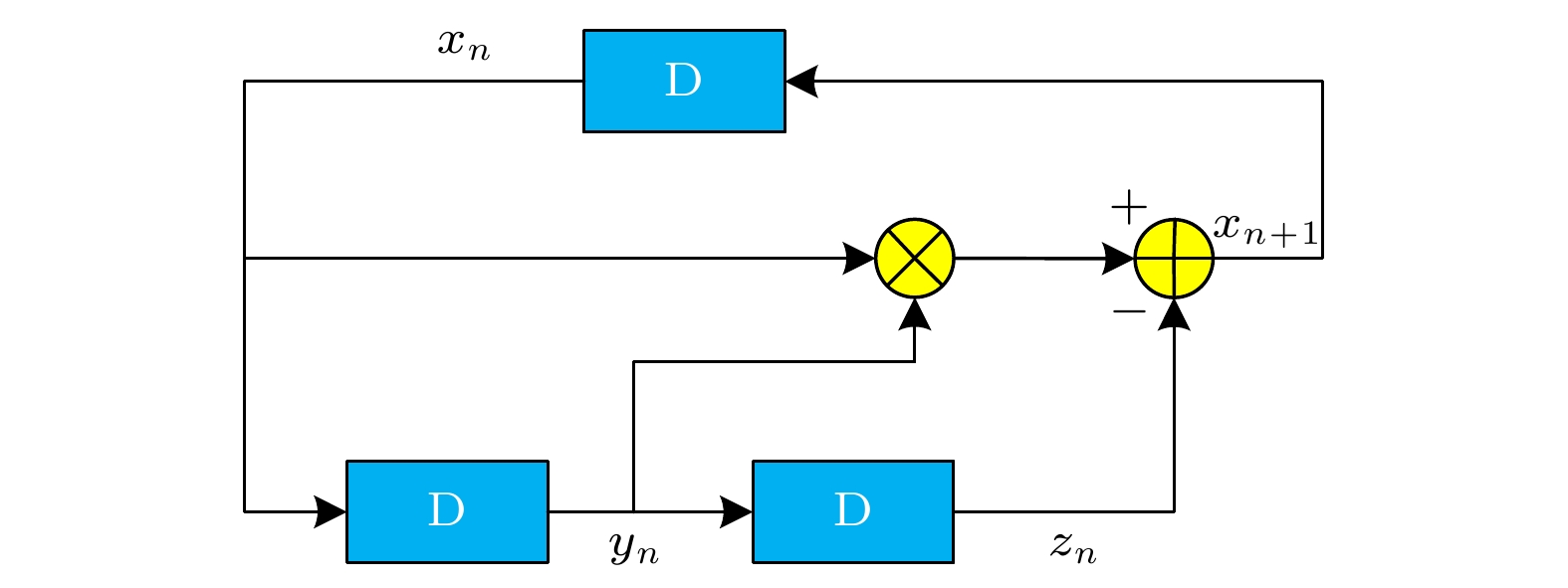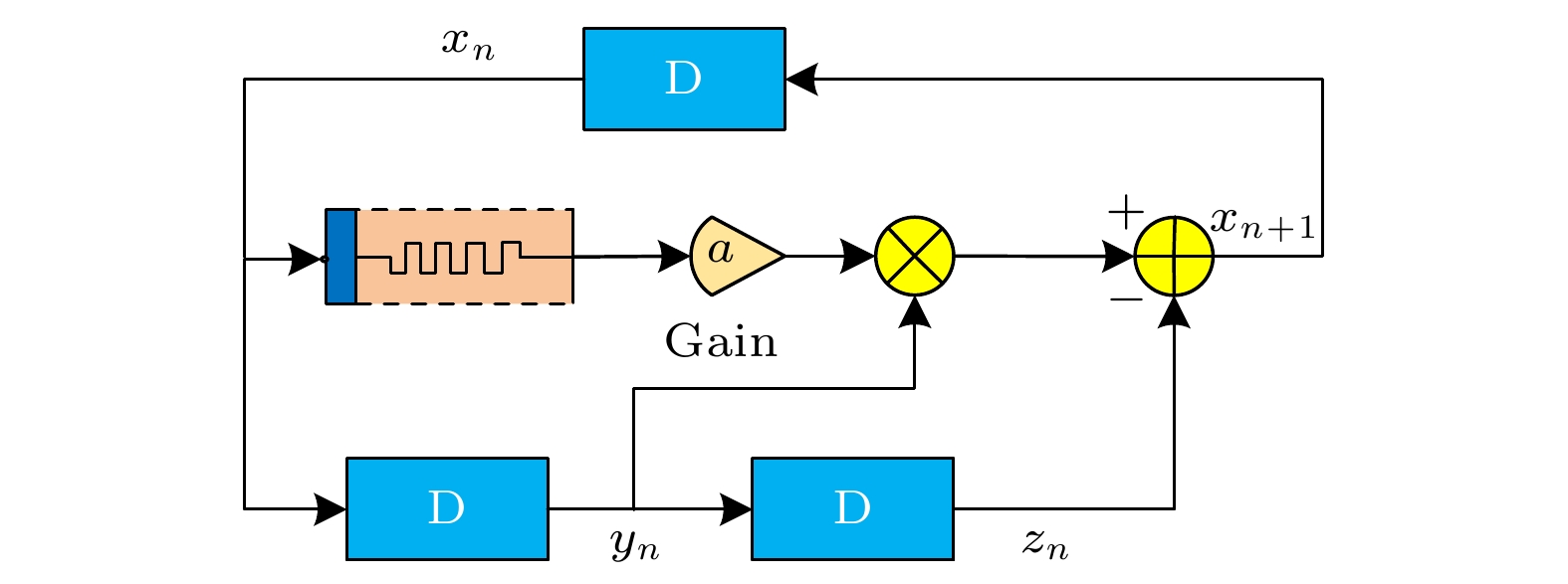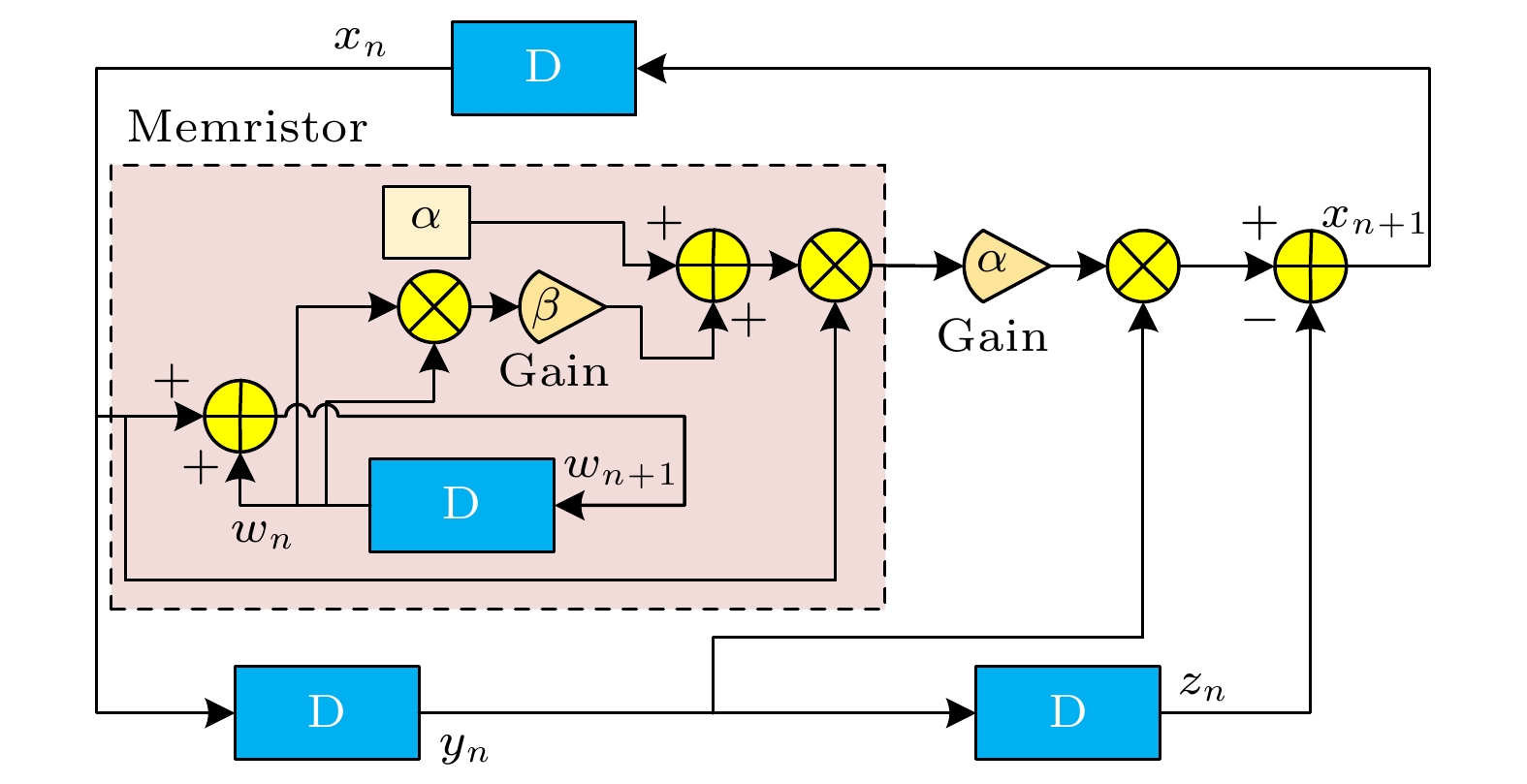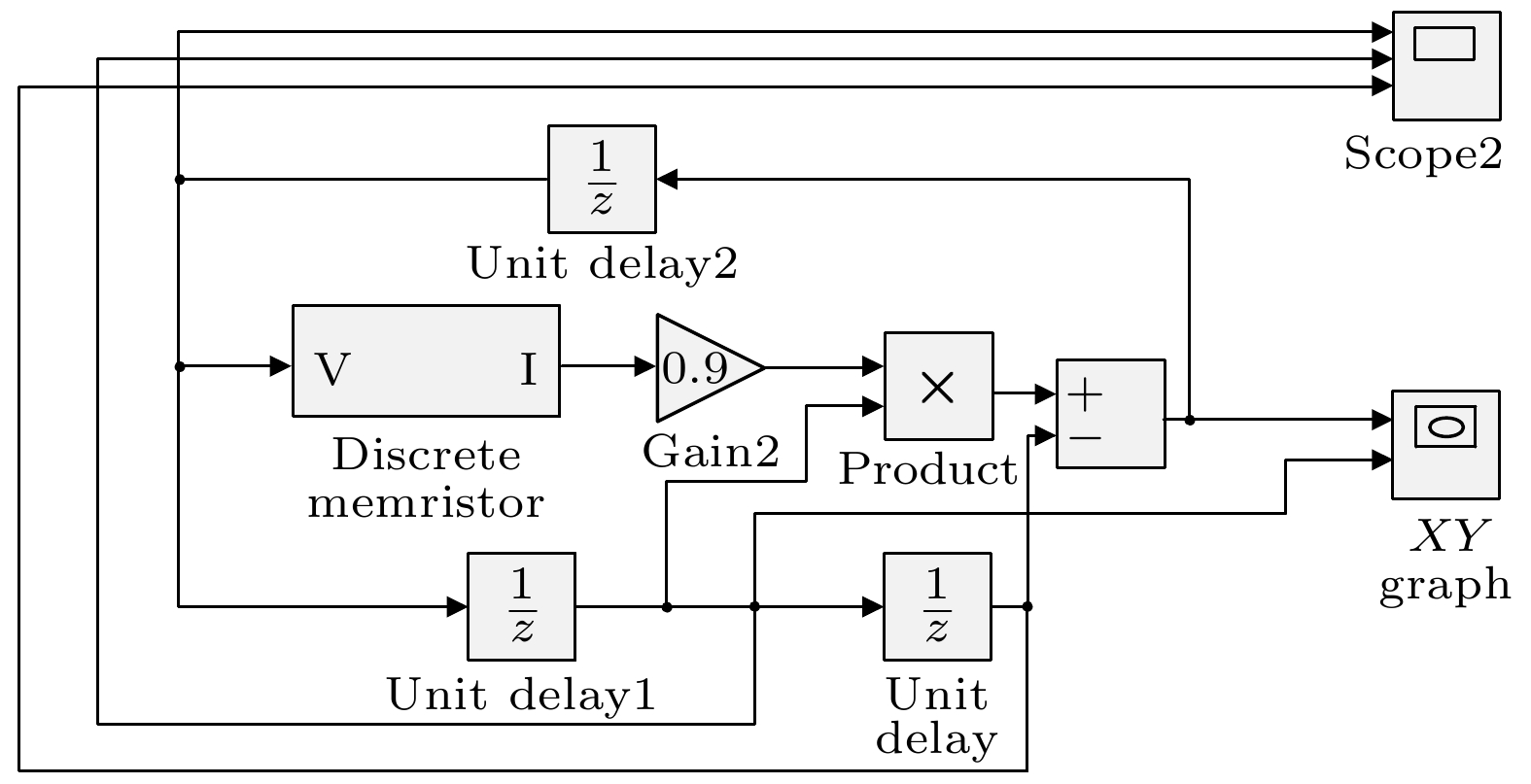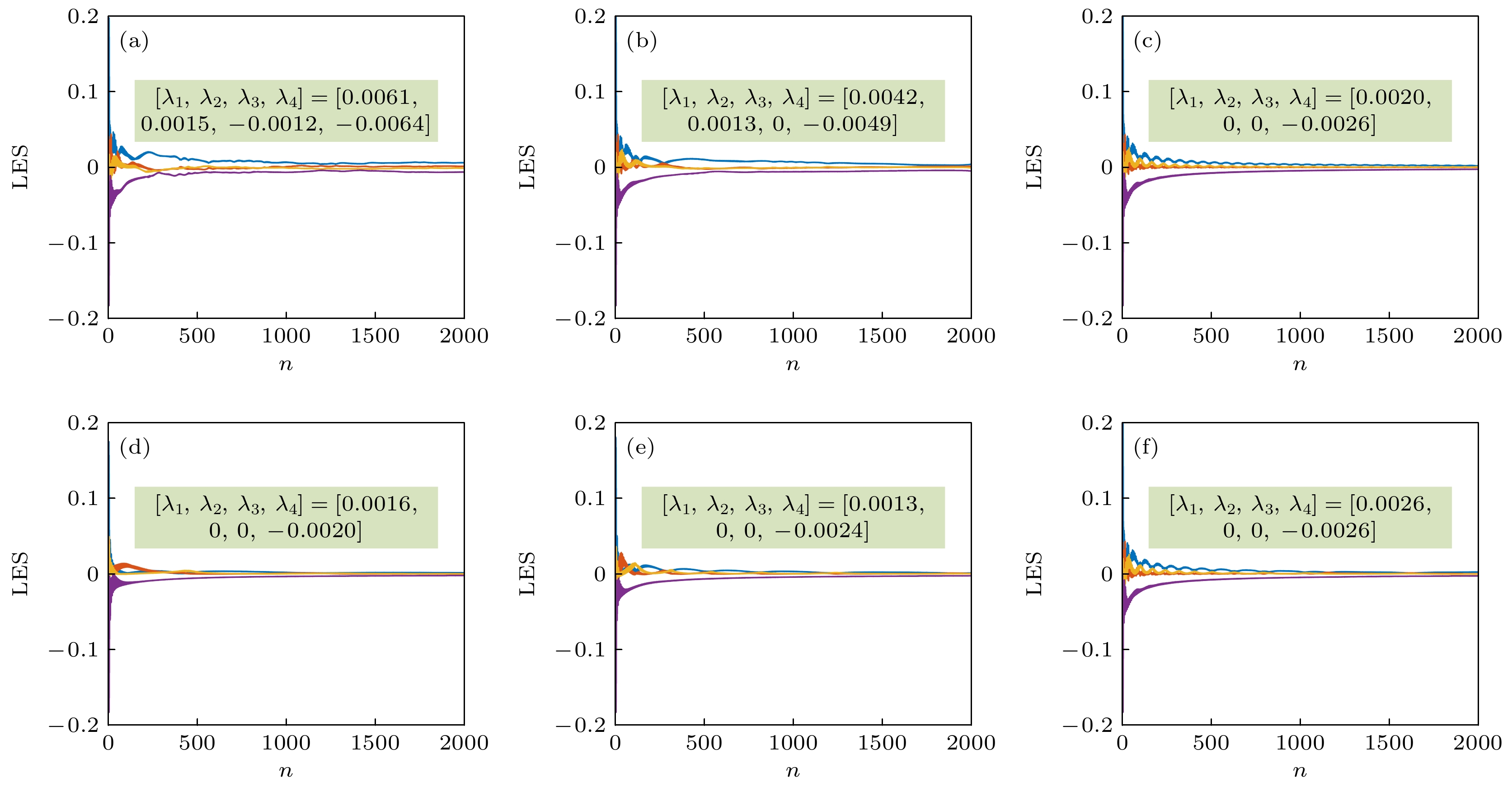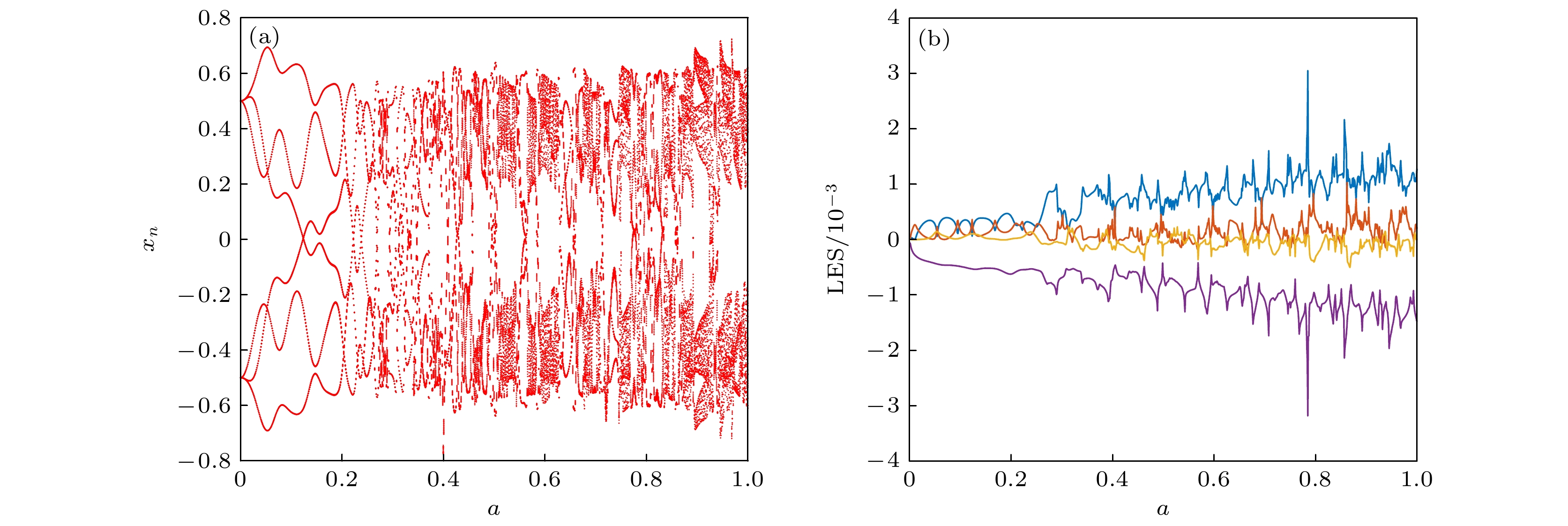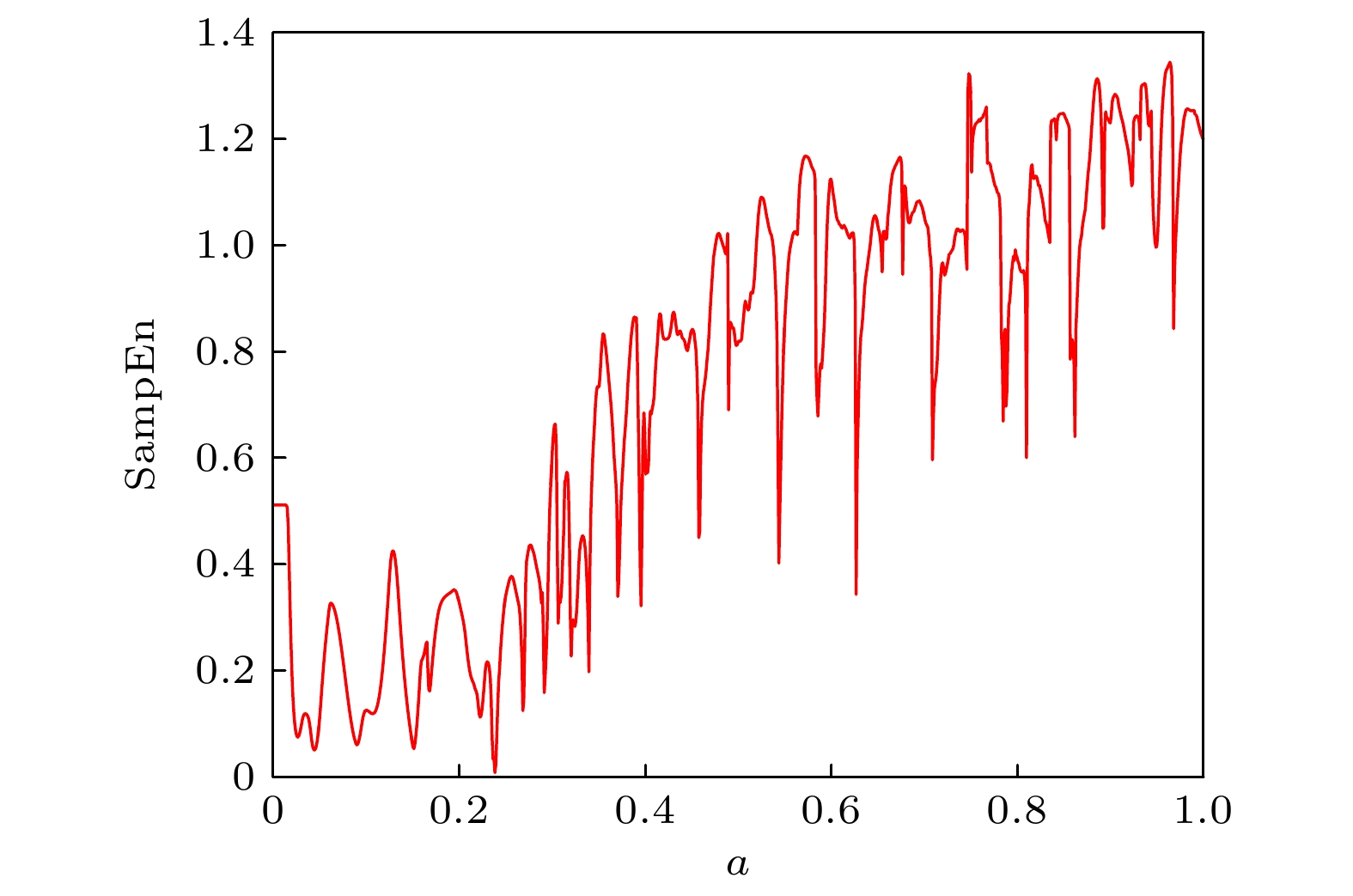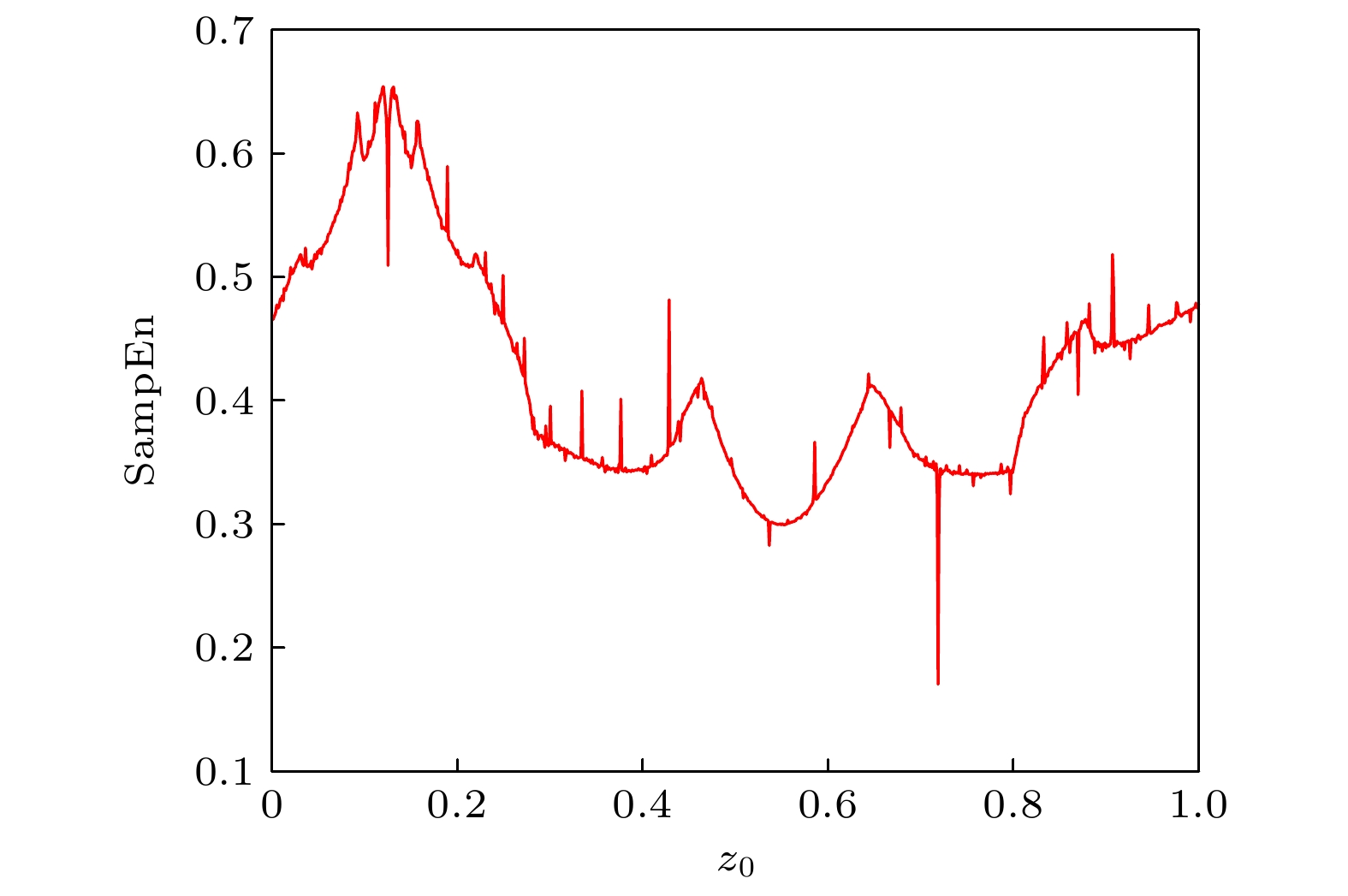-
In the last two years, the discrete memristor has been proposed, and it is in the early stages of research. Now, it is particularly important to use various simulation softwares to expand the applications of the discrete memristor model. Based on the difference operator, in this paper, a discrete memristor model with quadratic nonlinearity is constructed. The addition, subtraction, multiplication and division of the discrete memristor mathematical model are clarified, and the charge q is obtained by combining the discrete-time summation module, thereby realizing the Simulink simulation of the discrete memristor. The simulation results show that the designed memristor meets the three fingerprints of memristor, indicating that the designed discrete memristor belongs to generalized memristor. Using memristors to construct chaotic systems is one of the current research hotspots, but most of the literature is about the introduction of continuous memristors into continuous chaotic systems. In this paper, the obtained discrete memristor is introduced into a three-dimensional chaotic map which is mentioned in a Sprott’s book titled as Chaos and Time-Series Analysis, and a new four-dimensional memristor chaotic map is designed. Meanwhile, the Simulink model of the chaotic map is established. It is found that attractors with different sizes and shapes can be observed by changing the parameters in the Simulink model, indicating that the changes of system parameters and memristor parameters can change the dynamic behavior of the system. The analyses of equilibria and equilibrium stability show that the four-dimensional chaotic map has infinite equilibrium points. The Lyapunov exponent spectra and bifurcation diagrams of the circuit imply that the map can transform between weak chaotic state, chaotic state, and hyperchaotic state. Meanwhile, the multistability and coexisting attractors are analyzed under different initial conditions. Moreover, by comparing the results of measuring the complexity, it is found that the chaotic map with discrete memristor has richer dynamical behaviors and higher complexity than the original map. From the perspective of system modeling, in this paper the discrete memristor modeling and discrete memristor map designing are discussed based on the Matlab/Simulink. It further verifies the realizability and lays a foundation for the future applications of discrete memristor. -
Keywords:
- discrete memristor /
- chaotic map /
- dynamic characteristics /
- Simulink
[1] Chua L O 1971 IEEE Trans. Circuit. Theory 18 507
 Google Scholar
Google Scholar
[2] Strukov D B, Snider G S, Stewart D R, Williams R S 2008 Nature 453 80
 Google Scholar
Google Scholar
[3] Haj-Ali A, Ben-Hur R, Wald N, Ronen R, Kvatinsky S 2018 IEEE Micro. 38 13
 Google Scholar
Google Scholar
[4] Zhang Y, Shen Y, Wang X P, Cao L 2015 IEEE Trans. Circuits Syst. I 62 1402
 Google Scholar
Google Scholar
[5] Ho P W C, Almurib H A F, Kumar T N 2016 J. Semicond. 37 104002
 Google Scholar
Google Scholar
[6] Teimoori M, Amirsoleimani A, Ahmadi A, Ahmadi M 2018 IEEE Trans. Very Large Scale Integr. (VLSI) Syst. 26 2608
 Google Scholar
Google Scholar
[7] Wang C H, Xiong L, Sun J R, Yao W 2019 Nonlinear Dyn. 95 2893
 Google Scholar
Google Scholar
[8] Duan S K, Hu X F, Dong Z K, Wang L, Mazumder P 2015 IEEE Trans. Neural. Netw. Learn Syst. 26 1202
 Google Scholar
Google Scholar
[9] Marco M D, Forti M, Pancioni L, Innocenti G, Tesi A 2020 IEEE Trans. Syst. Man. Cybern. DOI: 10.1109/TCYB.2020. 2997686
[10] Pham V T, Jafari S, Vaidyanathan S, Volos C, Wang X 2016 Sci. China:Technol. Sci. 59 358
 Google Scholar
Google Scholar
[11] Xu Q, Song Z, Bao H, Chen M, Bao B C 2018 Int. J. Electron. Commun. 96 66
 Google Scholar
Google Scholar
[12] Pershin Y V, Di Ventra M 2010 IEEE Trans. Circuits Syst. 57 1857
 Google Scholar
Google Scholar
[13] Biolek D, Di Ventra M, Pershin Y V 2013 Radioengineering 22 945
[14] Gergel-Hackett N, Wright A, Fullerton F A, Joe A 2021 J. Circuits Syst. Comput. 30 2120002
 Google Scholar
Google Scholar
[15] 段飞腾, 崔宝同 2015 固体电子学研究与进展 35 231
Duan F T, Cui B T 2015 Res. Prog. Solid State Elec. Tron. 35 231
[16] 胡柏林, 王丽丹, 黄艺文, 胡小方, 张宇阳, 段书凯 2011 西南大学学报 33 50
 Google Scholar
Google Scholar
Hu B L, Wang L D, Huang Y W, Hu X F, Zhang Y Y, Duan S K 2011 J. Southwest Univ. 33 50
 Google Scholar
Google Scholar
[17] 王晓媛, 俞军, 王光义 2018 物理学报 67 098501
 Google Scholar
Google Scholar
Wang X Y, Yu J, Wang G Y 2018 Acta Phys. Sin. 67 098501
 Google Scholar
Google Scholar
[18] 王春华, 蔺海荣, 孙晶茹, 周玲, 周超, 邓全利 2020 电子与信息学报 42 795
 Google Scholar
Google Scholar
Wang C H, Lin H R, Sun J R, Zhou L, Zhou C, Deng Q L 2020 J. Electr. Inf Technol. 42 795
 Google Scholar
Google Scholar
[19] Fitch A L, Yu D S, Iu H H C, Sreeram V 2012 Int. J. Bifurcat. Chaos 22 1250133
 Google Scholar
Google Scholar
[20] Bao H, Jiang T, Chu K B, Chen M, Xu Q, Bao B C 2018 Complexity 2018 1
 Google Scholar
Google Scholar
[21] Buscarino A, Fortuna L, Frasca M, Gambuzza L V 2012 Chaos 22 023136
 Google Scholar
Google Scholar
[22] Li Q D, Zeng H Z, Li J 2015 Nonlinear Dyn. 79 2295
 Google Scholar
Google Scholar
[23] Ma J, Chen Z Q, Wang Z L, Zhang Q 2015 Nonlinear Dyn. 81 1275
 Google Scholar
Google Scholar
[24] Zhou L, Wang C H, Zhou L L 2017 Bifurcat. Chaos 27 1750027
 Google Scholar
Google Scholar
[25] 阮静雅, 孙克辉, 牟俊 2016 物理学报 65 190502
 Google Scholar
Google Scholar
Ruan J Y, Sun K H, Mou J 2016 Acta Phys. Sin. 65 190502
 Google Scholar
Google Scholar
[26] Bao B C, Jiang T, Xu Q, Chen M, Wu H G, Hu Y H 2016 Nonlinear Dyn. 86 1711
 Google Scholar
Google Scholar
[27] Teng L, Iu H H C, Wang X Y, Wang X K 2014 Nonlinear Dyn. 77 231
 Google Scholar
Google Scholar
[28] Cang S J, Wu A G, Wang Z G, Xue W, Chen Z Q 2016 Nonlinear Dyn. 83 1987
 Google Scholar
Google Scholar
[29] He S B, Sun K H, Peng Y X, Wang L 2020 AIP Adv. 10 015332
 Google Scholar
Google Scholar
[30] Bao B C, Liu Z, Xu J P 2010 Chin. Phys. B 19 030510
 Google Scholar
Google Scholar
[31] Adhikari S P, Sah M P, Kim H, Chua L O 2013 Trans. Circuits Syst. I, Reg. 60 3008
 Google Scholar
Google Scholar
[32] Sprott J C 2003 Chaos and Time-Series Analysis (Oxford: Oxford University Press) pp46–102
[33] Peng Y X, Sun K H, He S B 2020 Chaos Solitons Fract. 137 109873
 Google Scholar
Google Scholar
[34] Chen W T, Zhuang J, Yu W X, Wang Z Z 2009 Med. Eng. Phys. 31 61
 Google Scholar
Google Scholar
[35] Yuan F, Wang G Y, Wang X W 2016 Chaos 26 507
 Google Scholar
Google Scholar
-
图 7 四维忆阻混沌映射(9)的Simulink仿真吸引子图 (a) β = –0.1, 超混沌状态; (b) β = –0.02, 超混沌状态; (c) β = –0.000002, 混沌状态; (d) a = 0.25, 混沌状态; (e) a = 0.5, 混沌状态; (f) a = 0.9, 混沌状态
Fig. 7. Simulink simulation results of the four-dimensional memristor chaotic map (9): (a) β = –0.1, hyperchaotic; (b) β = –0.02, hyperchaotic; (c) β = –0.000002, chaos; (d) a = 0.25, chaos; (e) a = 0.5, chaos; (f) a = 0.9, chaos.
图 8 四维忆阻混沌映射(9)的Simulink仿真吸引子图对应Lyapunov指数谱 (a) β = –0.1, 超混沌状态; (b) β = –0.02, 超混沌状态; (c) β = –0.000002, 混沌状态; (d) a = 0.25, 混沌状态; (e) a = 0.5, 混沌状态; (f) a = 0.9, 混沌状态
Fig. 8. Simulink simulation attractor diagram of the four-dimensional memristor chaotic map (9) corresponds to Lyapunov Exponent spectra: (a) β =
–0.1, hyperchaotic; (b) β = –0.02, hyperchaotic; (c) β = –0.000002, chaos; (d) a = 0.25, chaos; (e) a = 0.5, chaos; (f) a = 0.9, chaos. 图 11 随初值z0变化的Lyapunov指数谱 (a)四维忆阻混沌映射(9), a = 0.25; (b) 四维忆阻混沌映射(9), a = 0.5; (c) 三维Lorenz混沌映射(6)
Fig. 11. Lyapunov exponent spectra with initial value z0: (a) Four-dimensional memristor chaotic map (9), a = 0.5; (b) four-dimensional memristor chaotic map (9), a = 0.5; (c) three-dimensional Lorenz chaotic map (6).
图 14 随初值变化的分岔图 (a) 初值y0变化, x0 = 0.5, z0 = 0.5, w0 = 0.4; (b)初值z0变化, x0 = 0.5, y0 = 0.5, w0 = 0.4; (c) 初值w0变化, x0 = 0.5, y0 = 0.5, z0 = 0.5
Fig. 14. Bifurcation diagrams with the initial values: (a) Initial value y0 changes, x0 = 0.5, z0= 0.5, w0 = 0.4; (b) initial value z0 changes, x0 = 0.5, y0 = 0.5, w0 = 0.4; (c) initial value w0 changes, x0 = 0.5, y0 = 0.5, z0 = 0.5.
-
[1] Chua L O 1971 IEEE Trans. Circuit. Theory 18 507
 Google Scholar
Google Scholar
[2] Strukov D B, Snider G S, Stewart D R, Williams R S 2008 Nature 453 80
 Google Scholar
Google Scholar
[3] Haj-Ali A, Ben-Hur R, Wald N, Ronen R, Kvatinsky S 2018 IEEE Micro. 38 13
 Google Scholar
Google Scholar
[4] Zhang Y, Shen Y, Wang X P, Cao L 2015 IEEE Trans. Circuits Syst. I 62 1402
 Google Scholar
Google Scholar
[5] Ho P W C, Almurib H A F, Kumar T N 2016 J. Semicond. 37 104002
 Google Scholar
Google Scholar
[6] Teimoori M, Amirsoleimani A, Ahmadi A, Ahmadi M 2018 IEEE Trans. Very Large Scale Integr. (VLSI) Syst. 26 2608
 Google Scholar
Google Scholar
[7] Wang C H, Xiong L, Sun J R, Yao W 2019 Nonlinear Dyn. 95 2893
 Google Scholar
Google Scholar
[8] Duan S K, Hu X F, Dong Z K, Wang L, Mazumder P 2015 IEEE Trans. Neural. Netw. Learn Syst. 26 1202
 Google Scholar
Google Scholar
[9] Marco M D, Forti M, Pancioni L, Innocenti G, Tesi A 2020 IEEE Trans. Syst. Man. Cybern. DOI: 10.1109/TCYB.2020. 2997686
[10] Pham V T, Jafari S, Vaidyanathan S, Volos C, Wang X 2016 Sci. China:Technol. Sci. 59 358
 Google Scholar
Google Scholar
[11] Xu Q, Song Z, Bao H, Chen M, Bao B C 2018 Int. J. Electron. Commun. 96 66
 Google Scholar
Google Scholar
[12] Pershin Y V, Di Ventra M 2010 IEEE Trans. Circuits Syst. 57 1857
 Google Scholar
Google Scholar
[13] Biolek D, Di Ventra M, Pershin Y V 2013 Radioengineering 22 945
[14] Gergel-Hackett N, Wright A, Fullerton F A, Joe A 2021 J. Circuits Syst. Comput. 30 2120002
 Google Scholar
Google Scholar
[15] 段飞腾, 崔宝同 2015 固体电子学研究与进展 35 231
Duan F T, Cui B T 2015 Res. Prog. Solid State Elec. Tron. 35 231
[16] 胡柏林, 王丽丹, 黄艺文, 胡小方, 张宇阳, 段书凯 2011 西南大学学报 33 50
 Google Scholar
Google Scholar
Hu B L, Wang L D, Huang Y W, Hu X F, Zhang Y Y, Duan S K 2011 J. Southwest Univ. 33 50
 Google Scholar
Google Scholar
[17] 王晓媛, 俞军, 王光义 2018 物理学报 67 098501
 Google Scholar
Google Scholar
Wang X Y, Yu J, Wang G Y 2018 Acta Phys. Sin. 67 098501
 Google Scholar
Google Scholar
[18] 王春华, 蔺海荣, 孙晶茹, 周玲, 周超, 邓全利 2020 电子与信息学报 42 795
 Google Scholar
Google Scholar
Wang C H, Lin H R, Sun J R, Zhou L, Zhou C, Deng Q L 2020 J. Electr. Inf Technol. 42 795
 Google Scholar
Google Scholar
[19] Fitch A L, Yu D S, Iu H H C, Sreeram V 2012 Int. J. Bifurcat. Chaos 22 1250133
 Google Scholar
Google Scholar
[20] Bao H, Jiang T, Chu K B, Chen M, Xu Q, Bao B C 2018 Complexity 2018 1
 Google Scholar
Google Scholar
[21] Buscarino A, Fortuna L, Frasca M, Gambuzza L V 2012 Chaos 22 023136
 Google Scholar
Google Scholar
[22] Li Q D, Zeng H Z, Li J 2015 Nonlinear Dyn. 79 2295
 Google Scholar
Google Scholar
[23] Ma J, Chen Z Q, Wang Z L, Zhang Q 2015 Nonlinear Dyn. 81 1275
 Google Scholar
Google Scholar
[24] Zhou L, Wang C H, Zhou L L 2017 Bifurcat. Chaos 27 1750027
 Google Scholar
Google Scholar
[25] 阮静雅, 孙克辉, 牟俊 2016 物理学报 65 190502
 Google Scholar
Google Scholar
Ruan J Y, Sun K H, Mou J 2016 Acta Phys. Sin. 65 190502
 Google Scholar
Google Scholar
[26] Bao B C, Jiang T, Xu Q, Chen M, Wu H G, Hu Y H 2016 Nonlinear Dyn. 86 1711
 Google Scholar
Google Scholar
[27] Teng L, Iu H H C, Wang X Y, Wang X K 2014 Nonlinear Dyn. 77 231
 Google Scholar
Google Scholar
[28] Cang S J, Wu A G, Wang Z G, Xue W, Chen Z Q 2016 Nonlinear Dyn. 83 1987
 Google Scholar
Google Scholar
[29] He S B, Sun K H, Peng Y X, Wang L 2020 AIP Adv. 10 015332
 Google Scholar
Google Scholar
[30] Bao B C, Liu Z, Xu J P 2010 Chin. Phys. B 19 030510
 Google Scholar
Google Scholar
[31] Adhikari S P, Sah M P, Kim H, Chua L O 2013 Trans. Circuits Syst. I, Reg. 60 3008
 Google Scholar
Google Scholar
[32] Sprott J C 2003 Chaos and Time-Series Analysis (Oxford: Oxford University Press) pp46–102
[33] Peng Y X, Sun K H, He S B 2020 Chaos Solitons Fract. 137 109873
 Google Scholar
Google Scholar
[34] Chen W T, Zhuang J, Yu W X, Wang Z Z 2009 Med. Eng. Phys. 31 61
 Google Scholar
Google Scholar
[35] Yuan F, Wang G Y, Wang X W 2016 Chaos 26 507
 Google Scholar
Google Scholar
计量
- 文章访问数: 9244
- PDF下载量: 302
- 被引次数: 0














 下载:
下载:

